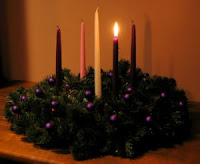Advent

We often think of Advent as the beginning of the church year. However, the church's calendar is more cyclical than linear. Thus, one does not so much observe a beginning and ending as an ongoing cycle moving from one theme to another. The traditional Advent Wreath may be an appropriate way to illustrate this, as we move toward Christmas by moving in a circle, a symbol of eternity. One half of the year reflects on the life of the church, the other on the life of Christ. Advent does make us think of beginnings and endings as it points us in anticipation to the end of time and the return of Christ, as well as the birth of Jesus. Yet the best way to think of Advent is to see it in terms of the fulfillment of prophesy. How do we know that Jesus will come again in glory, as He promised? The answer is found in His first coming, the incarnation. In a sense past, present and future are collapsed and made a single whole. As we look back we find assurance to look ahead in hope. Th